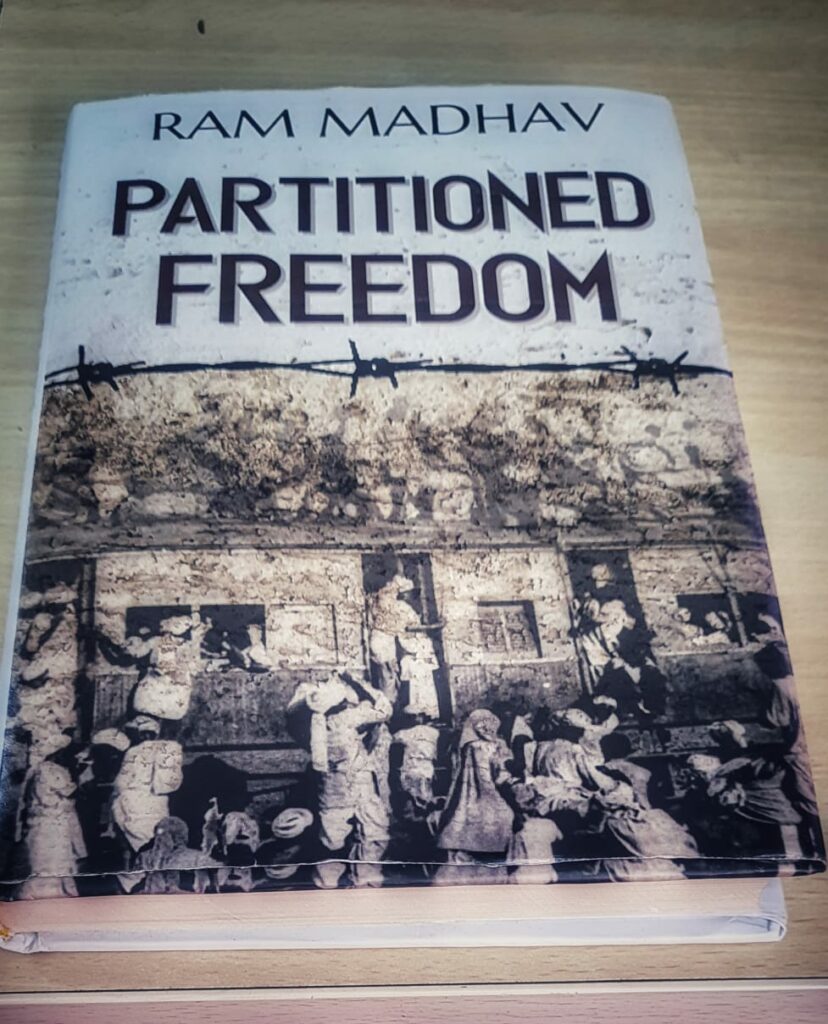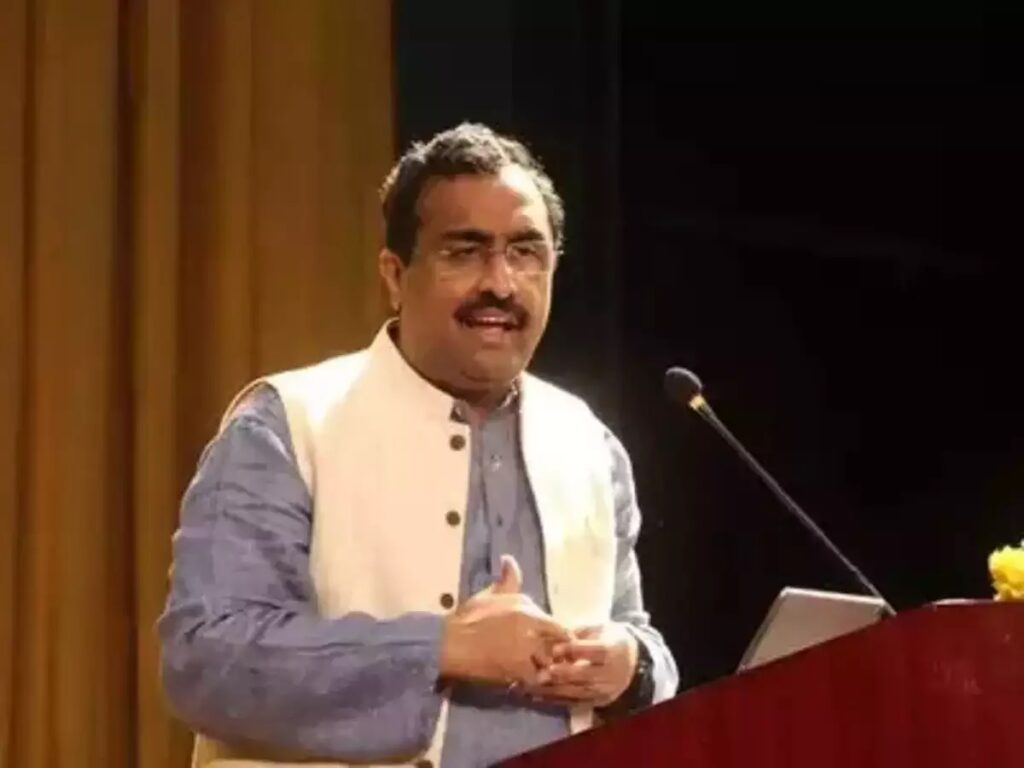
Ram Madhav’s recent book “Partitioned Freedom” offers us a new and different perspective on the most troubled and traumatized times of modern Indian history, from the beginning of the 1900s to India’s political freedom, in 1947. This a thought-provoking title, which focuses on the events, incidents and chronicles that led to the fractured, amputated and divided India, which was up in communal flares across the country raging with famines and extreme levels of poverty. He delves into the inevitability of partition, despite the fact that most leaders in the mainstream freedom struggle, were against even the notion and the idea of partition. When the Idea, was formally materialized by the Muslim League, in the 1940 Lahore session, most Indian Leaders, dismissed it and thought that it would never be possible to divide the Indian subcontinent.
The priorities of Indian leaders were different. Gandhiji believed that Hindu-Muslim unity can be achieved first and then we must fight for Independence, but 20 years later, in 1940, he realized that Hindu-Muslim unity can wait, but firstly, we need to fight for Independence for a United India. But by that time, it was too late to gear back or recalibrate the strategy as the congress party had given out massive concessions for the seeding of communally divisive Muslim politics in the country. Ram Madhav points out a very intriguing fact that in 1905 when the partition of Bengal was announced by the British Raj, an all-India movement under the leadership of Lal, Bal, Pal (Lala Lajpat Rai, Bal Gangadhar Tilak, Bipin Chandra Pal) vigorously put up a resistance, and ultimately in 1911, the decision was withdrawn. But how come when Jinnah took a call for the partition, the whole national leadership failed to prevent it?
As the author investigates this question, he discovers that there was a repeated, inadvertent and zealous attempt to bring about Hindu-Muslim unity, by the Congress party, which went on giving concessions one after the other, to the Muslim league, and the politics of appeasement was systematically increased by the party. But the Muslim League in this whole process was constantly in the process of fortifying and strengthening its positions, towards fundamentalist divisiveness and glorifying its Islamist commonality to its zenith. In fact, the separate communal electorate which was achieved by the Muslim League, for the subcontinent’s Muslims was a result of the repeated appeasement of the Congress, especially by Gandhi. Though Gandhi was committed to keeping India united, it was too late for him to take any necessary actions to bridge the gaps between both communities. Congress had shuttered down the opportunity and chances to bring about the needed communal unity for two decades.
The author discovers that there was a repeated, inadvertent and zealous attempt to bring about Hindu-Muslim unity, by the Congress party, which went on giving concessions one after the other, to the Muslim league, and the politics of appeasement was systematically increased by the party.
Several concessions and compromises were made on the issues of the national flag, the national language, and the singing of bhajans in the congress sessions and even with the singing of Vande Mataram, which is the national song of India. By doing so Congress intended that the religious sentiments of the conservative Muslims of those times, should not be hurt. On every such issue, they went on compromising with the very recalcitrant behaviour of the Muslim leaguers in the hope that these compromises would bring them closer to congress, but they utterly failed in achieving their objectives. What instead happened was a complete polarization of the political environment which led to repeated strife and communal riots across the country. The communal harmony of India was completely shattered.
The author brings about an interesting and rather puzzling fact in the book when he mentions how Gandhi, in the early 1940s realizes that his Hindu-Muslim unity was backfiring, and he went on to the extent of offering to Jinnah that “You(Jinnah) take over the leadership of the whole country, but please keep the country united” (pg 174). Jinnah out-rightly declined this offer given by Gandhi. Later, he told one of his biographers that “ you see I knew Gandhi well, He would have first thrown the British out, promising me the whole country, but later he would have thrown me out also”, “so I did not believe in that man”(pg 176 and pg 177). Such was the distrust that Jinnah had towards Gandhi. But interestingly, the seeds of differences and discontent were sown in the very first meeting between Jinnah and Gandhi, in the year 1915. In Mumbai, a felicitation program was organized by the Gujarati Samaj, to honour and felicitate Gandhi, on his return from South Africa. This session was chaired by Jinnah, who also happened to be a fellow Gujarati. Gandhi was in fact very happy to see a Muslim chairing this session and perhaps saw an avenue for communal harmony between the Hindus and the Muslims. Jinnah started to address the gathering in English. But Gandhi interrupted Jinnah and asked him to address the crowd in the Gujarati language, as the program was organized by the Gujarati samaj, and Gandhi probably wanted to connect with Jinnah through his Gujarati “asmitha” which is an intrinsic cultural and linguistic connection. Jinnah however felt taunted, and did not agree to speak in Gujarati and continued to speak in English. This was the first mild clash or difference of opinion that sprouted between Gandhi and Jinnah.

It’s quite astonishing to know that Jinnah left the congress party, with the growing discontent between him and Gandhi, in the year 1920, when Gandhi agreed to support the Khilafat movement. Jinnah got disgruntled with this decision, as it had nothing to do with India’s freedom struggle, and was aimed at agitating against the British for dethroning the Sultan of Turkey, who was considered by the Muslims as their Kalifah (Supreme theocratic leader). The reason for Jinnah’s exit from congress was his secular credentials. In his early years, he practised inclusive and liberal politics. Religion was initially not in his scheme of things, in the political domain. Jinnah left India and started staying in England for a couple of years thinking that there was little or no scope for him in mainstream Indian politics. But Mohammad Iqbal, who was leading the Muslim League in the 1930s appealed to him to rejoin the political movement in a new avatar. Iqbal told Jinnah that he can survive in the Indian mainstream political movement, only if you play the Muslim political card. Iqbal convinced Jinnah by pointing out three critical points, which Islamist nationalists had realized by that time.
A) If the goal of All-India nationalism could be realized, it would result in the domination of Hindus over the Muslims, because of the overwhelming numerical majority of the Hindus.
B) The concept of nationalism would promote narrow patriotic feelings among the Muslims of different countries, and loosen the bonds of Islamic fraternity, across the world.
C) The Muslims of the Indian subcontinent must openly embrace the concept of Ummah (Global Muslim Solidarity) and aim for a separate theocratic state.
Gandhi kept on changing his position according to the change in the political atmosphere and the evolution of time.
Jinnah was highly motivated by Iqbal’s appeal and took a new avatar in the late 1930s as the principal leader of the Muslim league. He turned from being secular to a communal Islamist. A non-religious, non-namaz reading, and a non-Masjid going Muslim, was now destined to become the principal architect and the Father of the Pakistani republic. This turn of events from the 1920s to 1940s ultimately led to the materialization of Pakistan’s dream, by the Muslim nationalists. Their position kept on strengthening as the Congress, under Gandhi went on making compromises, to appease and pander to the Muslim communalists. And Gandhi failed to stop partition despite putting all the efforts into talking to all the Leaders in Muslim League, with the British officials and other top bureaucratic stakeholders in the establishment.
The author highlights the fact that post-1945, after the end of the 2nd world war, when India was marching closer towards its independence, the Congress leadership stopped consulting Gandhi on important national matters. So much so, that even the plan for India’s partition was not discussed with Gandhi. But in 1947, when the proposal of partition was placed before Congress, most of the CWC (Congress Working Committee) was very agitated and furious about the proposal, which was jointly placed by Jawaharlal Nehru and Sardar Patel. Most CWC members opposed the proposal of India’s partition and were highly reluctant to support it. But surprisingly Gandhi intervenes and says “This is the best decision to arrive at this moment, and our leaders (referring to Nehru and Patel) are sound leaders, don’t be mad at them, please! Accept it”(pg196). When Gandhi met the leaders of the CWC soon after this resolution was passed, they asked him as to, is this (partitioned freedom) is what he wanted. Which showed their disenchantment with Gandhi’s acceptance of independence, through partition; Gandhi replied to this and said that “Independence has been won, but the General has been dethroned” (pg194).
If Gandhi had not forced his Hindu-Muslim unity strategy after understanding the communal realities of the subcontinent, India wouldn’t have got partitioned freedom.
Gandhi kept on changing his position according to the change in the political atmosphere and the evolution of time. He used to say, “Consistency is the quality of the dead”, and he believed that one has to be consistent with the truths, and not any other perceptions. Perhaps no one can dispute the fact that Nehru and Patel had an important role to play in the partition of India. In fact, Nehru confessed in a 1956 interview that as to why they agreed to a partitioned Independence pact with the British, “we were becoming old; we no longer wanted to continue this fight with the Muslim League, in the streets”. This makes it evidently clear how our national leaders were responsible for the partition, as an inevitability, and not as a conscious choice.
The author stresses the fact that “one thing that we must keep in the mind is, we must not compromise with the separatist forces like the Muslim League, as we clearly encounter those statements even to this day. The Integrity and the unity of the country is something for which one should be ready to sacrifice the utmost”. Quoting how Netaji Subhas Chandra Bose upheld the unity and integrity of a United India, without making any compromises or concessions to the communal forces, the author extols his vigorous yet benevolent leadership qualities.
The author gives the impression that, if Gandhi had not forced his Hindu-Muslim unity strategy, which was successful in South Africa against the imperialist struggle; by understanding the communal realities of the subcontinent, India wouldn’t have got partitioned freedom.
(The author has an MA in International Relations. Views expressed are author’s own)
Book: Partitioned Freedom
Author: Ram Madhav
Publishers: Prabhat Prakashan
Price (Hardcover): Rs. 325
SW Ratings: ****
Viswapramod is a PhD Scholar at the Department of International Studies and Political Science, Christ University, Bangalore. He has an MA in International Relations. Views expressed are the author’s own.
